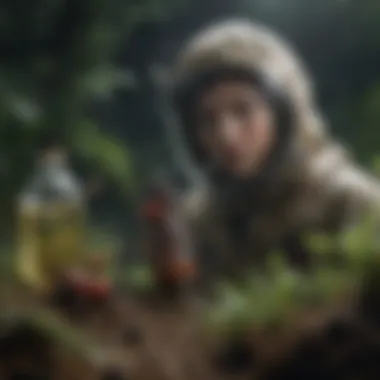The Environmental Consequences of Pesticide Use


Intro
Pesticides are widely used in agriculture to enhance crop production and control pests. However, their extensive use raises concerns about their impact on the environment. This article will explore the various dimensions of pesticide use and its far-reaching implications on ecosystems and health.
Article Overview
Purpose of the Article
The primary aim is to analyze how pesticides affect the environment. This includes not just the immediate effects on plants and animals, but also the longer-term consequences on biodiversity and human health. A detailed exploration of chemical properties and their behavior in different ecosystems will be offered.
Relevance to Multiple Disciplines
Pesticide usage intersects with numerous fields such as environmental science, agriculture, public health, and policy-making. Understanding the implications of pesticide use is crucial for fostering sustainable agricultural practices.
Research Background
Historical Context
The introduction of synthetic pesticides in the 20th century revolutionized agriculture. Initially, these chemicals were celebrated for eliminating pests that threatened food security. Over time, however, the environmental costs began to manifest, leading to increased scrutiny and regulatory responses.
Key Concepts and Definitions
- Pesticides: Chemicals used to kill or control pests. They include herbicides, insecticides, and fungicides.
- Biodiversity: The variety of life in a particular habitat or ecosystem, which can be adversely affected by pesticide application.
- Ecosystems: A community of living organisms and their interactions with the environment, sensitive to chemical inputs.
"The relationship between pesticides and environmental health is complex, necessitating careful examination of both immediate and long-term consequences."
"The relationship between pesticides and environmental health is complex, necessitating careful examination of both immediate and long-term consequences."
This analysis will set the foundation for understanding the intricate dynamics at play between agricultural practices and the health of our planet.
Understanding Pesticides
Pesticides play a crucial role in modern agriculture and pest control. They are designed to eliminate or mitigate the impact of pests that threaten crops, livestock, and public health. The necessity to understand pesticides is driven by their widespread use and the implications they carry for environmental health and human safety. Knowledge about pesticides encompasses their definitions, classifications, and chemical properties, setting the groundwork for evaluating their environmental impacts.
Definition and Classification
Pesticides are substances used to prevent, destroy, or control pests. They can include insecticides, herbicides, fungicides, and rodenticides. Each type targets specific pests, ranging from insects to weeds and fungi.
- Insecticides are aimed at controlling insect populations.
- Herbicides are designed to combat unwanted vegetation, or weeds.
- Fungicides prevent or eliminate fungal diseases.
- Rodenticides target rodents that may damage crops or spread disease.
The classification of pesticides can also be based on their chemical structure. Common categories include organophosphates, carbamates, pyrethroids, and neonicotinoids. Understanding these classifications is essential for assessing their behavior in the environment, their toxicity, and the risk they pose to non-target species.
Usage Trends Globally
The global usage of pesticides has increased, driven by the growing need for food security and the expansion of agricultural practices. This trend varies across regions, influenced by factors like economic development, agricultural policies, and pest pressure. For instance:
- Developed regions tend to use more sophisticated chemicals, with a substantial focus on integrated pest management strategies.
- Developing countries may rely on older, less-targeted pesticide applications, leading to higher environmental risks.
Several reports highlight that the adoption of pesticide use correlates with increased crop yields but raises concerns about the long-term effects on biodiversity and soil health. Examining these trends helps in recognizing the balance between productivity and sustainable practices.
Chemical Composition and Properties
The chemical composition of pesticides affects their efficacy and environmental impact. Most pesticides consist of active ingredients that target specific pests, accompanied by inert additives which help in application and stability. These components can vary widely in their behavior and persistence in the environment.
Key characteristics to consider include:
- Solubility - Determines how a pesticide interacts with water and soil.
- Volatility - Affects how easily a pesticide can evaporate and disperse into the atmosphere.
- Degradation rate - Influences how long the pesticide remains active in the environment.
Understanding these chemical properties allows researchers and policymakers to gauge risks related to non-target organisms, groundwater contamination, and broader ecological impacts.
"Knowledge of pesticide chemical properties is essential to predict their behavior in the environment and assess potential risks."
"Knowledge of pesticide chemical properties is essential to predict their behavior in the environment and assess potential risks."
In summary, understanding pesticides establishes an important viewpoint that underlies the evaluation of their environmental ramifications. This comprehension aids in creating more informed agricultural practices and environmental policies.
Pesticide Impact on Soil Health
Pesticides have a significant impact on soil health, which is a critical aspect of agricultural sustainability. Healthy soil is essential for plant growth, water retention, and carbon sequestration. The use of pesticides can lead to short-term benefits in crop production, but the long-term effects on soil microbial communities and overall soil structure need careful consideration. Understanding these impacts is crucial for developing sustainable agricultural practices and policies that prioritise environmental health alongside food production.
Soil Microbial Diversity
Soil microbial diversity refers to the variety of microorganisms present in the soil, including bacteria, fungi, and protozoa. These microbes play an essential role in nutrient cycling, organic matter decomposition, and soil structure formation. However, the application of pesticides can disrupt this diversity.
Pesticides often target specific organisms to control pests, but non-target organisms can also be affected. For instance, beneficial microbes that promote plant growth may be killed off, leading to a decline in soil health. Studies have shown that pesticide exposure can reduce microbial populations, alter community composition and disrupt vital functions such as nitrogen fixation and decomposition.


Soil Structure and Fertility
Soil structure is vital for maintaining fertility, water infiltration, and root penetration. Healthy soil has a crumbly structure that allows air and water to circulate effectively, creating an optimal environment for plants to thrive. Pesticides can harm the physical properties of soil. When applied in excess, pesticides may lead to the formation of hydrophobic layers, resulting in reduced water retention and soil compaction.
In addition, chemical residues can create imbalances in soil nutrients, affecting the fertility of the land. Sustainable practices should be emphasized to mitigate these negative impacts, such as reducing pesticide use or adopting safer alternatives.
Long-Term Soil Degradation
Long-term exposure to pesticides can lead to soil degradation, diminishing its ability to support agriculture. Prolonged pesticide use can lead to detrimental shifts in soil chemistry, reducing organic matter and soil fertility. As fertility declines, soils become less productive, which may require even more pesticide use to achieve desired yields—a cycle that is difficult to break.
Moreover, soil degradation can lead to erosion and loss of topsoil, which are irreversible processes. Protecting soil health is not just about preventing immediate harm from pesticides; it also involves considering how those harms accumulate over time and affect future generations' ability to produce food sustainably.
"Soil health is the foundation of agricultural productivity; neglecting it due to pesticide use could have catastrophic consequences for future food security."
"Soil health is the foundation of agricultural productivity; neglecting it due to pesticide use could have catastrophic consequences for future food security."
Ecosystem Disruption Due to Pesticides
Ecosystems are intricate networks of living organisms and their environments. Pesticides play a substantial role in these systems, affecting various components within the ecological balance. The use of pesticides is often justified as a means to control pests that threaten crops. However, the broader implications of this practice cannot be overlooked. Understanding how pesticides disrupt ecosystems is crucial for developing informed management strategies.
Impacts on Flora
Pesticides can have severe effects on plant life, leading to a decline in biodiversity. When pesticides are applied, they do not solely target the intended pests. Non-target plant species can suffer from both direct and indirect effects. For instance, herbicides can eliminate weed species that provide essential habitats for various organisms. This reduction in plant diversity can impact food sources for wildlife.
Additionally, some pesticides may interfere with the plant’s growth and reproductive abilities. Certain chemicals can cause phytotoxicity—leading to stunted growth or even deaths of vital plant species. Consequently, this has a cascading effect, diminishing the overall health of the ecosystem. Healthy plants are essential for soil stability and provide crucial oxygen and nutrients.
Effects on Fauna
Pesticides pose significant risks to animal populations, ranging from insects to larger mammals. Many species experience acute toxicity from exposure to these chemicals, which can result in mortality or reproductive failures. For instance, pollinators such as bees are particularly vulnerable. Exposure to neonicotinoids and similar compounds has been linked to decreases in bee populations, which are vital for pollinating many crops and flowering plants.
Moreover, predatory species may also be affected by pesticide use, as they accumulate toxins through the food chain. This phenomenon, known as biomagnification, can lead to population decline and even extinction of certain species. The loss of keystone species can disrupt predator-prey dynamics, potentially leading to overpopulation of prey species and underpopulation of predators.
Alterations in Trophic Levels
The use of pesticides alters the established balance of trophic levels within ecosystems. Trophic levels represent the different stages of energy transfer through an ecosystem, often illustrated as a pyramid. Each level is essential for maintaining the integrity of the ecosystem. Disturbances caused by pesticide use can lead to changes in these levels, thereby impacting species interactions and energy flow.
When certain species decline due to pesticide exposure, it can create a vacuum in the food web. For example, an absence of certain insects may cause a decline in birds that prey on them, leading to further instability in the ecosystem. Additionally, if herbicide use significantly reduces plant diversity, it can limit food options for herbivores. This interconnectedness illustrates the delicate balance maintained in ecosystems and the ripple effects resulting from pesticide application.
Understanding the disruption caused by pesticides is vital for creating sustainable practices that prioritize ecological balance.
Understanding the disruption caused by pesticides is vital for creating sustainable practices that prioritize ecological balance.
In summary, the effects of pesticides extend well beyond immediate pest control. The disruption to flora and fauna, as well as alterations to trophic levels, highlight the need for careful consideration in agricultural practices. These insights emphasize the potential long-term consequences of pesticide use on ecological health, necessitating a shift towards sustainable solutions.
Water Contamination and Pesticides
Water contamination represents a significant concern regarding the widespread use of pesticides. Pesticides are designed to target specific pests, but they can inadvertently contaminate water sources through runoff and leaching. This contamination can have serious implications for ecosystems and human health.
The intersection of pesticides and water quality is multifaceted. When rain falls on agricultural fields treated with pesticides, the chemicals can wash into nearby streams, rivers, and lakes, affecting aquatic habitats. Groundwater, which serves as a crucial drinking source for many communities, is not immune. Once pesticides infiltrate the soil, they may reach the groundwater, leading to long-lasting contamination that is difficult to remediate.
Understanding the mechanisms by which pesticides contaminate water supplies is vital for developing effective regulatory measures and alternative practices. This section will explore the various routes of contamination and highlight the importance of addressing these issues for future environmental health.
Runoff and Groundwater Risk
The risk of pesticide runoff is particularly pronounced during heavy rainfall or irrigation. Agricultural activities can lead to over-application of pesticides, increasing the potential for runoff. When excess precipitation occurs, this runoff carries pesticide residues directly into water bodies.
Groundwater contamination can also arise from improper pesticide storage or application practices. The infiltration process can be gradual, allowing harmful substances to slowly reach aquifers. The implications of contaminated groundwater can be severe, as the purification process is complex and costly.
Experts emphasize the importance of assessing local hydrology and soil properties when applying pesticides. Practices that prevent runoff, such as buffer strips, can mitigate risks significantly. Moreover, cover crops can enhance soil integrity and reduce pesticide movement into water sources.
Impact on Aquatic Ecosystems
Pesticides entering aquatic ecosystems can disrupt the delicate balance of these environments. Water quality degradation can lead to detrimental effects on aquatic flora and fauna. Fish, amphibians, and macroinvertebrates are particularly vulnerable to pesticide exposure.
Research indicates that pesticides can cause toxic effects in aquatic organisms, potentially leading to reduced populations and impaired reproductive functions. For instance, pesticides like glyphosate and neonicotinoids have been shown to adversely affect fish and other aquatic life.
As a result, maintaining water quality is paramount for supporting biodiversity. Understanding how pesticides interact within aquatic ecosystems can help in formulating effective conservation strategies.
Drinking Water Safety Concerns
The presence of pesticides in drinking water is a growing public health concern. Contaminated drinking water can pose health risks, especially for sensitive populations such as children and pregnant women.
Monitoring programs frequently show that pesticide residues exceed safe limits in some regions, leading to heightened regulations and public advisories. Authorities are tasked with ensuring that drinking water is purified and free from harmful contaminants, which can involve significant investment in filtration and treatment technologies.
Furthermore, raising awareness among the public about these concerns is essential. Educational programs can guide communities on how to minimize pesticide-related risks and advocate for cleaner agricultural practices.
Effective management of pesticide application is critical in safeguarding both environmental and human health. Ensuring clean water sources is a collective responsibility.


Effective management of pesticide application is critical in safeguarding both environmental and human health. Ensuring clean water sources is a collective responsibility.
Pesticides and Biodiversity Loss
The issue of pesticides and biodiversity loss carries significant implications for environmental health and sustainability. As we delve deeper into this subject, it becomes clear that the interactions between pesticides and various forms of life are complex and multifaceted. Pesticides disrupt natural ecosystems, leading to a decline in biodiversity. This not only affects flora and fauna but also destabilizes the entire food web. The consequences are evident across ecosystems, impacting food security and ecological balance.
Reduction in Pollinator Populations
Pollinators like bees, butterflies, and other insects play an essential role in our environment. They are responsible for the pollination of many plants, including crops that humans rely on for food. The use of pesticides has been linked to alarming declines in pollinator populations. Studies show that certain pesticides, particularly neonicotinoids, can harm these beneficial insects. The chemicals disrupt their navigation, reproduction, and overall health.
The reduction in pollinator populations poses serious threats to agricultural productivity. Without adequate pollination, crop yields may decrease, leading to food scarcity. Protecting these organisms is crucial.
"The continual use of harmful pesticides threatens to upend both pollinator species and the food systems that depend on them."
"The continual use of harmful pesticides threatens to upend both pollinator species and the food systems that depend on them."
Threats to Endangered Species
Endangered species represent the most vulnerable segments of our biodiversity. When pesticides enter their habitats, the risk of extinction increases. Common effects include habitat degradation and direct poisoning. For instance, birds of prey may consume prey contaminated with pesticides, leading to population declines. Amphibians, which are sensitive indicators of ecosystem health, can also experience detrimental effects from these chemicals.
Furthermore, pesticide drift, where chemicals move away from the intended application area, can expose endangered species to toxic substances. Protecting these unique species requires strong regulations and dedicated conservation efforts.
Invasive Species Dynamics
The application of pesticides can alter the balance between native and invasive species. Some pesticide treatments may inadvertently benefit invasive species that have become resistant to those chemicals. This change can lead to a decline in native plants and animals, disrupting the ecosystem's equilibrium.
Invasive species often outcompete native ones for resources. This puts additional pressure on biodiversity. Understanding invasive dynamics in relation to pesticide use is necessary to develop effective management strategies. To mitigate these impacts, integrated approaches that discourage invasive species while protecting native biodiversity must be emphasized.
Health Risks Associated with Pesticide Use
Pesticides are a common tool in modern agriculture. However, their use comes with significant health risks. Examining these risks is crucial to understanding the broader implications of pesticide application on human health. Exposure to pesticides can occur through various routes, including inhalation, dermal contact, and ingestion. The understanding of these pathways is fundamental in assessing the potential impact of pesticides on individuals and communities.
Human Exposure Pathways
Humans can be exposed to pesticides in several ways. The most common pathways include:
- Agricultural Workers: Many pesticides are applied directly on fields. Workers in agriculture often experience high levels of exposure through handling pesticides or entering treated areas.
- Residue on Food: Wash the produce is often inadequate. Some pesticides leave residues on fruits and vegetables, resulting in ingestion risks when these foods are consumed.
- Airborne Particles: Pesticides can become airborne during their application. Wind can carry these particles, leading to exposure for nearby residents.
- Drinking Water Contamination: Pesticides can leach into groundwater or run off into nearby water sources. Consumption of contaminated water poses significant health risks.
Chronic Health Conditions
The long-term exposure to pesticides has been associated with various chronic health conditions. Research indicates several potential impacts:
- Cancer: Certain pesticides are considered carcinogenic, meaning long-term exposure can increase the risk of developing cancer.
- Neurological Disorders: Some studies have linked pesticide exposure to neurological disorders, including Parkinson's disease.
- Reproductive Issues: There can be negative effects on reproductive health, with some pesticides impacting fertility and fetal development.
The evidence on these health conditions indicates a pressing need for regulations and optimized safety measures regarding pesticide use.
Vulnerable Populations
Certain groups are more susceptible to the effects of pesticides. These vulnerable populations include:
- Children: Their developing bodies and smaller size make children more vulnerable to pesticides. The potential impact on neurological development raises significant concerns.
- Pregnant Women: Exposure can affect fetal development leading to long-term consequences on child health.
- Farm Workers: Often lacking proper safety measures, farm workers are at higher risk of exposure, leading to various health issues.
Understanding the unique vulnerabilities of these groups illustrates the importance of careful pesticide management and regulation.
"Recognizing the pathways of pesticide exposure and the potential health risks is essential in fostering safer practices in agriculture."
"Recognizing the pathways of pesticide exposure and the potential health risks is essential in fostering safer practices in agriculture."
Close attention to health risks associated with pesticide use can drive policy changes, encourage safer agricultural practices, and spark innovations in pest management alternatives.
Regulatory Framework Surrounding Pesticides
The regulatory framework surrounding pesticides is essential for ensuring their safe and effective use. This framework comprises a set of guidelines and rules that govern the application, sale, and distribution of pesticides. These regulations aim to protect human health, environmental integrity, and biodiversity. Understanding this framework helps stakeholders, including farmers, policymakers, and consumers, make informed decisions about pesticide use.
The importance of these regulations extends beyond mere compliance. They serve as a foundation for promoting sustainable agricultural practices. By establishing standards, the regulations can mitigate risks associated with pesticide application while encouraging innovation in safer alternatives. Furthermore, clear regulations can enhance public confidence in agricultural practices and food safety.
Global Regulations and Standards
Various global organizations have established regulations concerning pesticides. The Food and Agriculture Organization (FAO) and the World Health Organization (WHO) are two primary entities that set internationally recognized standards. The Codex Alimentarius, produced by these organizations, sets forth guidelines for pesticide residues in food and establishes safe limits for their use.
In addition to the Codex, several countries participate in agreements that aim to harmonize regulations across borders. This harmonization process supports international trade by reducing barriers related to pesticide quality and safety. For instance, the Rotterdam Convention regulates the international trade of certain hazardous chemicals, including pesticides.
National Policies and Practices
National regulations vary from one country to another, reflecting local agricultural practices and environmental conditions. In the United States, the Environmental Protection Agency (EPA) oversees the registration and regulation of pesticides. This agency evaluates the safety, efficacy, and environmental impacts of pesticides before they are permitted for use.


In Canada, the Pest Management Regulatory Agency (PMRA) is responsible for similar evaluations. These agencies assess risk through scientific studies and stakeholder input, ensuring that only those pesticides that meet safety standards enter the market. Countries in the European Union follow stringent criteria under the Registration, Evaluation, Authorisation and Restriction of Chemicals (REACH) regulation, which prioritizes risk management and public health.
Challenges in Implementation
Despite having comprehensive regulatory frameworks, several challenges exist in their implementation. One issue is the inconsistency between regulations and actual pesticide practices on the ground. Insufficient enforcement and lack of resources can result in non-compliance, leading to greater environmental harm.
Another challenge is the trade-off between agricultural productivity and environmental protection. Farmers often face pressure to increase yields, leading to the overuse of pesticides. Balancing productivity with safety requires careful consideration and education about integrated pest management practices.
Finally, public perception plays a significant role in how regulations are perceived. Misinformation about pesticides can create distrust, making it difficult for regulatory bodies to enforce regulations effectively. Efforts to enhance public awareness and education on pesticide risks and benefits are crucial for addressing these challenges.
"Effective regulation not only protects health and environment but also supports sustainable agricultural practices and innovation."
"Effective regulation not only protects health and environment but also supports sustainable agricultural practices and innovation."
Overall, understanding the regulatory framework surrounding pesticides is vital for fostering a safer agricultural environment. By navigating the complexity of these regulations, stakeholders can contribute to a more sustainable and healthy future.
Sustainable Alternatives to Pesticides
The sustainability of agriculture heavily relies on finding alternatives to traditional pesticide use. These alternatives aim not only to protect crops but also to safeguard the environment, thus addressing concerns of soil degradation, biodiversity loss, and human health risks associated with chemical treatments. Embracing sustainable practices helps mitigate the negative externalities of pesticide application and fosters environmental resilience.
Several elements bolster the case for sustainable pesticide alternatives: their lower environmental impact, enhanced soil health, and the promotion of biodiversity. In particular, addressing these components offers long-term ecological balance and encourages responsible land management. Moreover, adopting sustainable practices often leads to economic benefits, enhancing farm productivity and profitability in the long run.
Utilizing sustainable methods also requires consideration of local ecosystems and agroecological knowledge. These factors play a crucial role in determining which alternative approaches are most suitable, ultimately leading to better crop yields while preserving environmental integrity.
"Sustainable agriculture is not just about making choices; it's about recognizing the interconnectedness of our actions and their broader impact on ecosystems."
"Sustainable agriculture is not just about making choices; it's about recognizing the interconnectedness of our actions and their broader impact on ecosystems."
Integrated Pest Management (IPM)
Integrated Pest Management (IPM) is a multi-faceted approach that combines biological, cultural, physical, and chemical tools to manage pest populations. This strategy emphasizes the needs of the environment and uses pesticides conservatively, minimizing their adverse effects. It relies heavily on understanding pest biology, life cycles, and the dynamics of ecosystems.
Key components of IPM include:
- Monitoring and Identification: Frequent assessment of pest populations and accurate identification helps determine the best course of action.
- Cultural Controls: Adjustments in farming practices, such as crop rotation or intercropping, can help deter pests and reduce their impact.
- Biological Controls: Utilizing natural predators or pathogens to manage pests can effectively reduce their numbers without chemical interventions.
- Chemical Controls: When necessary, targeted pesticide applications avoid non-target organisms and preserve beneficial species.
By focusing on preventative measures and maintaining pest control thresholds, IPM can protect the harvest while keeping ecosystems intact.
Biological Control Methods
Biological control methods harness natural biological processes to combat pests. This approach involves introducing or enhancing the presence of natural enemies of pests, such as predators, parasitoids, or pathogens.
Examples of biological control agents include:
- Ladybugs: Effective against aphids and other soft-bodied insects.
- Nematodes: Microscopic worms that can target soil larvae and pests.
- Bacillus thuringiensis (Bt): A bacterium that is effective against caterpillars and other pests.
Using biological controls helps reduce reliance on synthetic chemicals. This strategy not only curtails environmental contamination but also fosters a more balanced ecosystem. However, successful implementation relies on understanding the nuances of each pest-predator relationship to avoid disruptions in the existing ecological balance.
Organic Farming Practices
Organic farming practices focus on cultivating crops without synthetic fertilizers and pesticides. This method emphasizes the use of natural inputs, crop rotations, and sustainable farming techniques. Organic practices vary by region, but common elements include:
- Crop Rotation: This method disrupts pest and disease cycles by alternating crop species each growing season.
- Composting: Natural fertilizers enrich soil health and fertility, supporting plant growth without chemical inputs.
- Natural Pest Management: Encouraging beneficial insects, such as bees and ladybugs, helps control pest populations.
Organic farming promotes biodiversity and improves soil health. Studies have shown that organic systems often yield comparably to conventional farms while having a reduced environmental footprint. With growing consumer demand for organic products, transitioning to organic practices can also provide economic opportunities for farmers in sustainable markets.
Future Directions in Pesticide Research
The domain of pesticide research is crucial, as it investigates innovative approaches and solutions to mitigate the negative impacts of pesticides on the environment and human health. Given the pressing challenges posed by traditional pesticide use, future directions in this field promise advancements that can enhance sustainability while maintaining agricultural productivity. This section will explore key elements such as innovations in pesticide formulation, advancements in toxicology, and the importance of public perception and education regarding pesticide use.
Innovations in Pesticide Formulation
Innovations in pesticide formulation are transforming how these chemicals are presented and their efficacy in combating pests. New formulations are being developed that reduce volatility and limit environmental exposure. Controlled-release formulations allow pesticides to be released gradually, minimizing runoff and improving effectiveness. Additionally, advancements in nanotechnology are enabling the design of smaller particles that can target pests more precisely, leading to reduced usage rates.
Another significant innovation is the shift towards biopesticides. Derived from natural materials like plants, bacteria, and minerals, biopesticides offer a more eco-friendly alternative to synthetic pesticides. They have been shown to be effective against various pests while posing fewer risks to non-target organisms and the environment.
Advancements in Toxicology
Advancements in toxicology play a vital role in understanding the effects of pesticides on environmental and human health. New methods in toxicological research are now focusing on systemic effects rather than merely acute toxicity. This shift is crucial, as it allows researchers to examine chronic exposure and its long-term consequences. For example, studies are now investigating how pesticides influence endocrine systems and contribute to various health conditions.
Moreover, integrative approaches combining toxicology with ecology are gaining attention. This interdisciplinary method assesses how pesticide exposure impacts not only individual organisms but also entire ecosystems. Researchers are increasingly employing in vivo and in vitro methodologies to gauge pesticide effects, ensuring a more comprehensive understanding of risks.
Public Perception and Education
Public perception and education are essential for future directions in pesticide research. The effectiveness of innovative practices depends heavily on societal acceptance and understanding of the necessity and safety of pesticide use. Increasing awareness through educational programs helps to foster informed opinions about pesticide regulations, their benefits, and their potential risks.
Engaging local communities in discussions about pesticides and promoting transparency in agricultural practices can significantly enhance public trust. Furthermore, collaborations between industries, governments, and educational institutions create a robust framework for disseminating accurate information, which is crucial for fostering sustainable practices.
"Research must be complemented by effective communication to bridge the gap between scientific advancements and public understanding."
"Research must be complemented by effective communication to bridge the gap between scientific advancements and public understanding."
As research progresses, it is vital to maintain an open dialogue with stakeholders, ensuring that innovations in pesticide research align with environmental, health, and agricultural goals. Educated consumers and communities can advocate for sustainable practices and contribute to formulating policies that balance agricultural productivity with environmental health.



